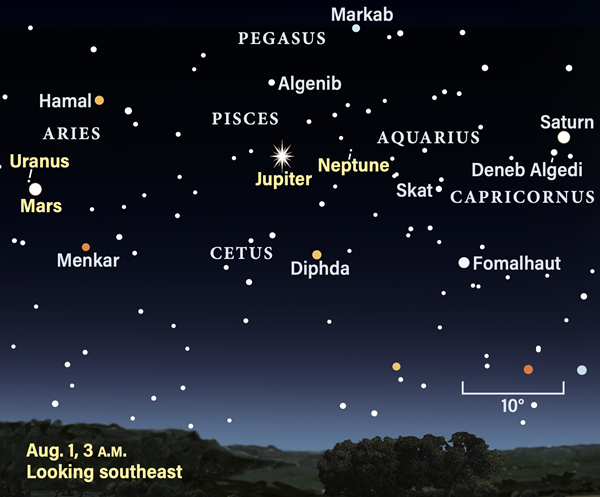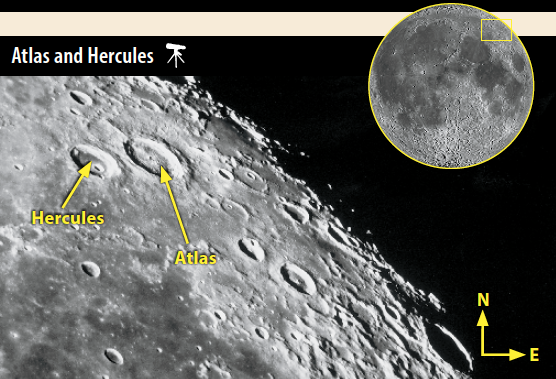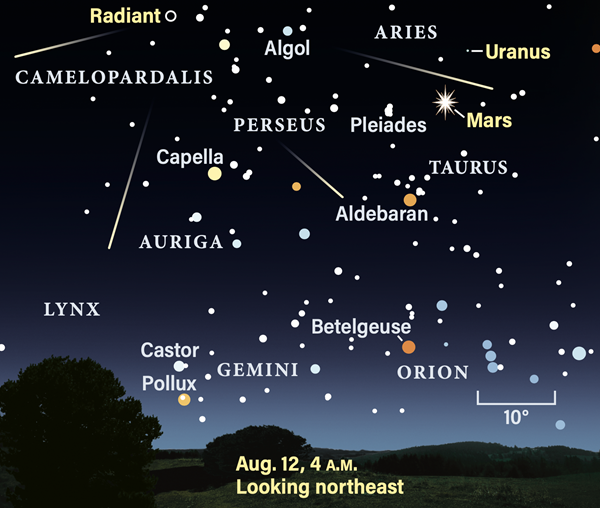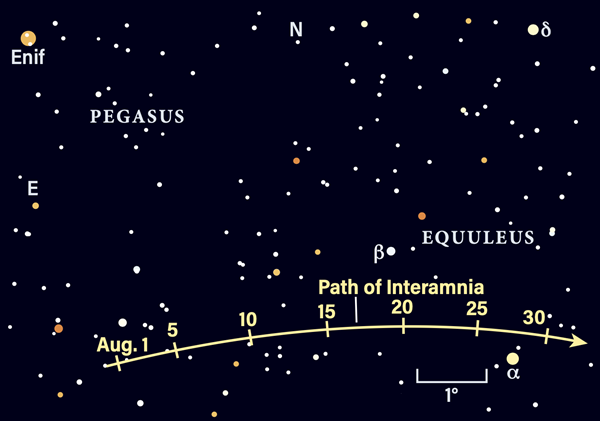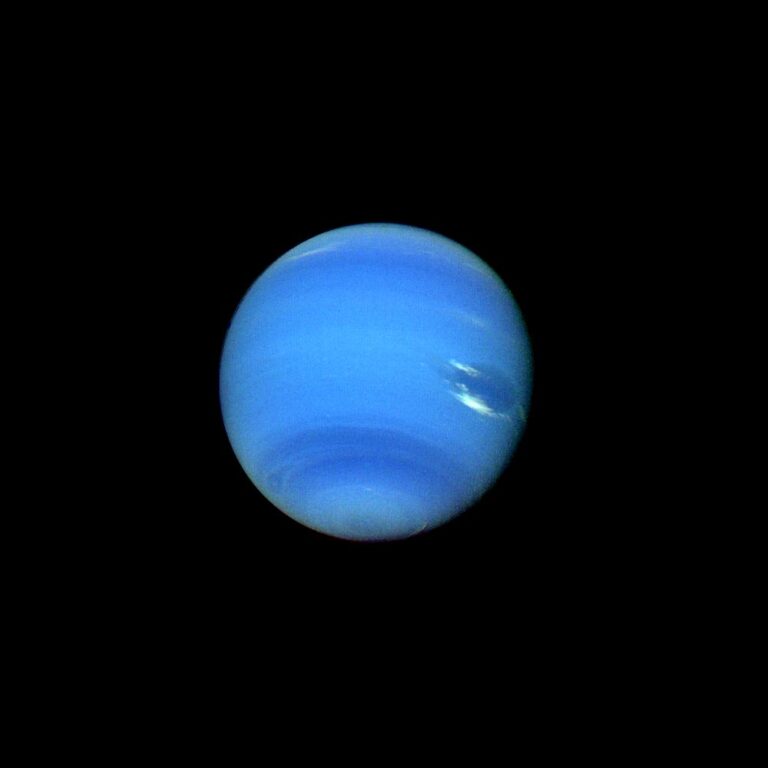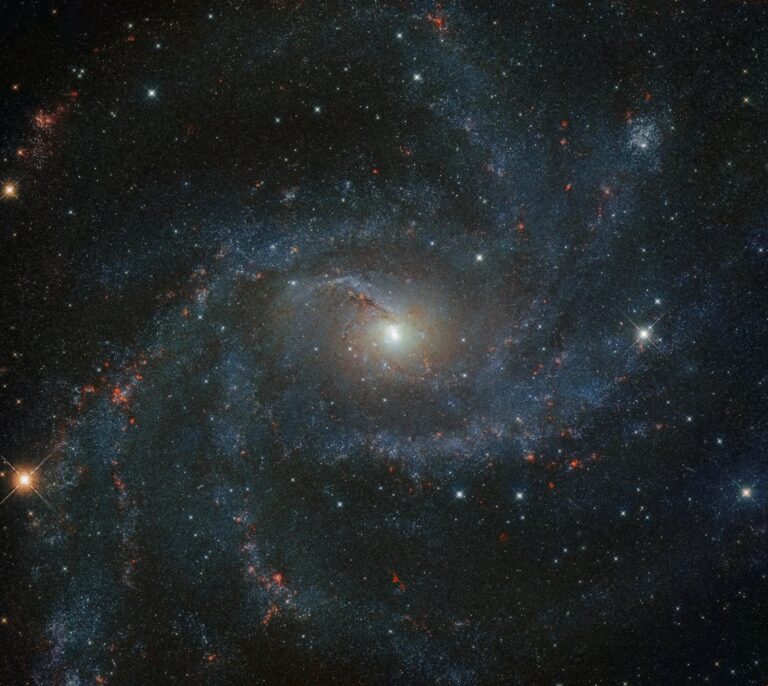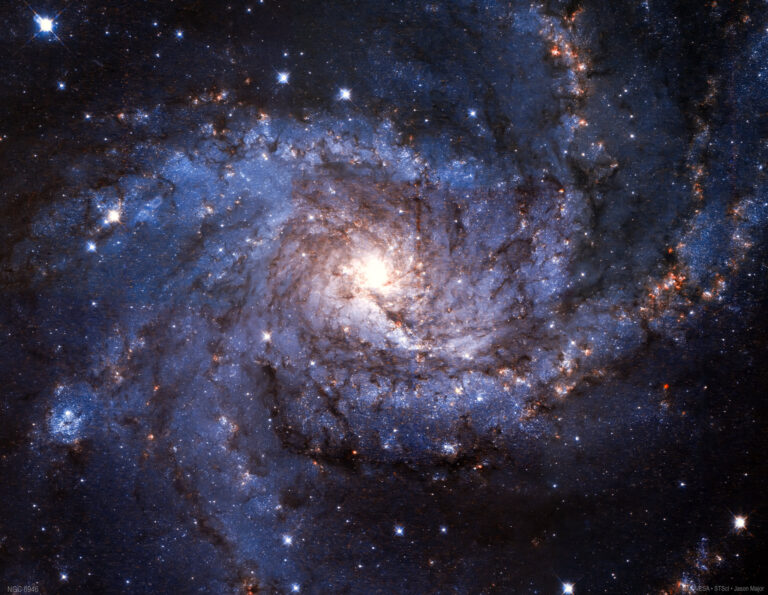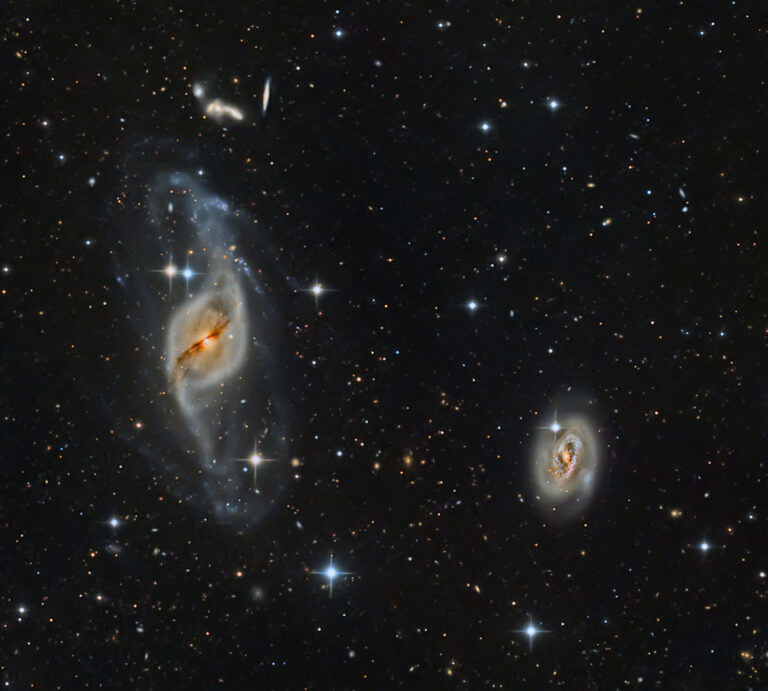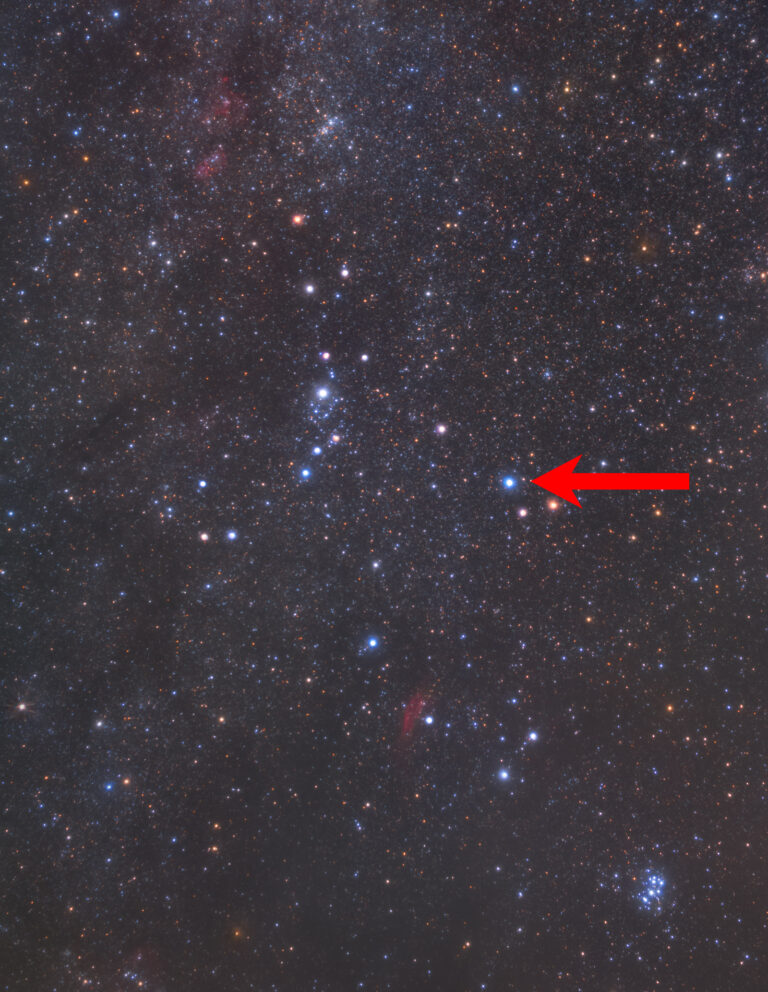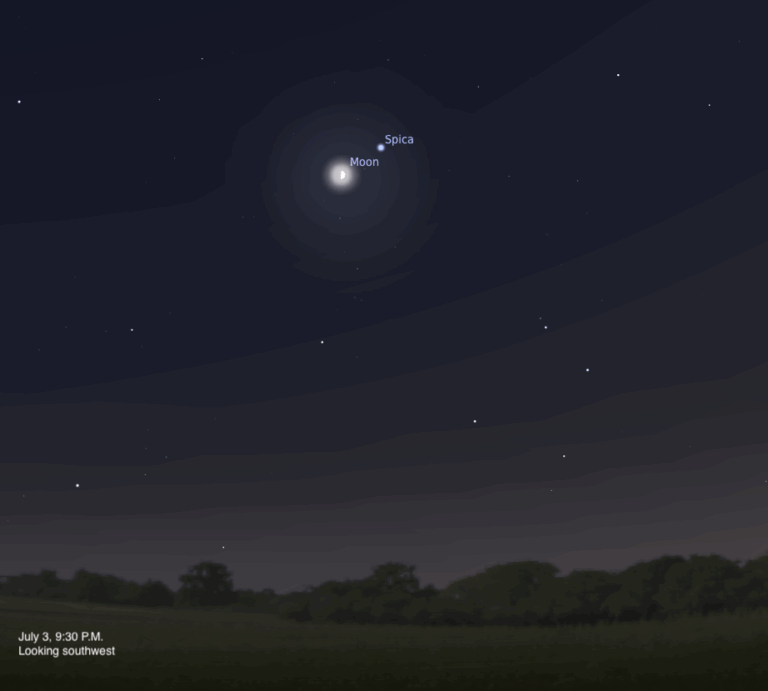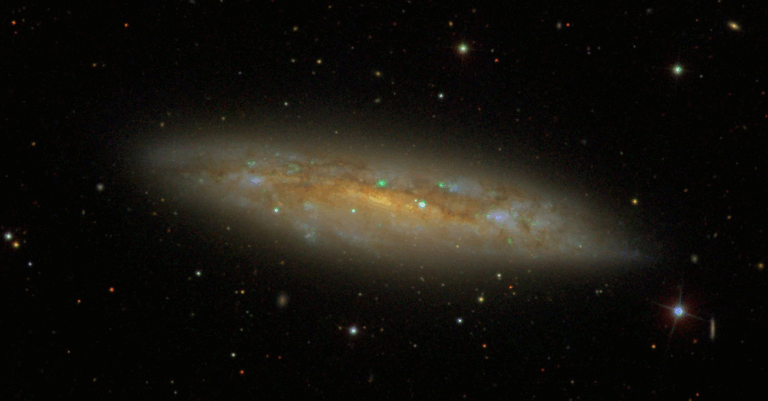Key Takeaways:
Midsummer observing means giant planets, with Jupiter and Saturn visible before midnight. Both planets offer hours of amazing views. Saturn is visible all night, while Jupiter rises a bit later. You might catch elusive Mercury in the early evening if you’re lucky. And the morning sky carries the glories of a growing Mars and a brilliant Venus.
Mercury modestly hugs the western horizon all month. It’s a favorable apparition for Southern Hemisphere observers but is more challenging for those in the Northern Hemisphere. On Aug. 3, soon after sunset, you’ll find it only 0.8° north of Regulus, although the pair sets within an hour of the Sun. Try 30 minutes after sunset to spot magnitude –0.5 Mercury 4° high; use binoculars to find fainter Regulus.
Mercury’s elevation after sunset doesn’t improve much as August progresses, although its elongation from the Sun increases. Mercury slides southward along the horizon. By Aug. 14, it fades to magnitude 0 and stands 5° high due west 30 minutes after sunset.
Mercury reaches greatest eastern elongation Aug. 27 and fades to magnitude 0.3 — difficult to see in bright twilight. Try spotting it in binoculars on the 28th and 29th, as a crescent Moon enters the scene. Mercury lies 9.5° left of the Moon on the 28th and 6.5° below the Moon on the 29th.
Saturn rises in the east soon before 9 P.M. local time on Aug. 1. It reaches opposition Aug. 14, so it is visible all night. The best time to view the planet is when it is highest in the southern sky, around 1 A.M. local time (local midnight using daylight saving time). It briefly brightens to magnitude 0.2 midmonth and is unmistakable within Capricornus the Sea Goat as the brightest object in this part of the sky.
You’ll find 3rd-magnitude Deneb Algedi (Delta [δ] Capricorni) near Saturn, 1.7° southeast of the planet as August opens. Saturn’s retrograde motion is easy to spot as the ringed planet wanders slowly westward at about 0.5° per week. August’s Full Moon, also opposite the Sun in the sky, lies within 5° of Saturn overnight on Aug. 11/12, shortly before the Perseid meteor shower peaks.
It’s the best time of the year to view Saturn’s rings, since the planet is closest to Earth at opposition (824 million miles), rendering the planet and its ring system at their largest apparent size to Earth dwellers. Saturn’s disk spans 19″ across the equator, but only 17″ from pole to pole — the planet’s somewhat flattened disk is now evident as the tilt of the rings reveals more of the southern polar regions.
The rings span nearly 43″ across and 10″ along the minor axis. Compare this year’s view to last summer’s, and you’ll notice the distinct change in ring tilt. By 2025, the rings will appear edge-on.
Titan, Saturn’s largest moon, is an easy target for small scopes. You’ll find it north of Saturn Aug. 5 and 21, and due south Aug. 13 and 29. On Aug. 19, a field star slightly dimmer than Titan’s magnitude 8.5 appears southwest of the planet; don’t confuse it for the moon, which lies southeast.
Closer to the rings, 10th-magnitude Tethys, Dione, and Rhea orbit with periods ranging from two to five days.
Two-toned Iapetus’ leading hemisphere is dark, causing the moon to appear faint at eastern elongations (12th magnitude) and brighter at western ones (10th magnitude). This month, Iapetus is brightest Aug. 7, when it reaches western elongation 9′ west of Saturn. It moves to superior conjunction early
Aug. 27 for U.S. observers.
Usually, Iapetus skims past the northern hemisphere of Saturn’s disk, but the current shallow tilt of its orbital plane causes an occultation instead. It’s a challenging event, given the brightness of Saturn and its rings, combined with Iapetus’ paltry 11th-magnitude glow. Digital imaging is likely to best capture the event. Iapetus lies just above the rings and begins to disappear around 12:25 A.M. EDT Aug. 27 (late on Aug. 26 in all other U.S. time zones).
Other moons also undergo eclipses and transits across the planet’s disk; these will increase over the next few years.
Neptune is an easy binocular object at magnitude 7.7. It starts the month in southwestern Pisces, 5° due south of Lambda (λ) Piscium, the Circlet’s southeasternmost star. You can also home in on Neptune by looking 13.5° southwest of Jupiter. The region is best viewed starting a couple of hours after midnight, when Neptune rises above 35° altitude in the southeastern sky.
Through binoculars on Aug. 1, you’ll find a star of similar brightness 0.4° to the planet’s east. Neptune’s motion carries it westward; on Aug. 31, the pair is 1° apart. A telescope will reveal the distant planet’s dim bluish disk, spanning a mere 2″. Neptune reaches opposition in September.
Jupiter lies in northwestern Cetus. It rises in the hour before midnight on Aug. 1 and soon before 9 P.M. local time by the 31st. It moves westward each night. Jupiter shines a brilliant magnitude –2.7 most of the month and reaches magnitude –2.8 in the last week of August.
The giant’s apparent diameter spans 49″ by late August. The best views are in the early morning hours, when the planet stands high in the southern sky. It lies due south at 53° altitude by 5 A.M. local time (an hour before sunrise) on Aug. 1, and by 3 A.M. on Aug. 31.
Small telescopes reveal parallel dark equatorial belts, while larger scopes show progressively more detail, tempered by local seeing conditions. The planet’s temperate zones contain many spots, including the Great Red Spot that features every alternate night on average. All these features move quickly across the planet’s face, carried by Jupiter’s roughly 10-hour rotation period.
The four Galilean moons orbit Jupiter every two to 16 days. Dual transits are fascinating to follow; a fine example occurs Aug. 15/16. Less than an hour after Jupiter rises in the Midwest, Io’s shadow begins a transit at 11:24 P.M. EDT. Io itself stands 19″ east of the planet’s limb at this time. Also spot Ganymede 36″ east of Io — note this for later. Io is the innermost large moon and moves faster than more distant Ganymede. Beginning at 11:59 P.M. EDT, Ganymede’s shadow appears southeast of Io’s shadow. Now two shadows race across the jovian cloud tops, but faster Io’s will stay well ahead. Io itself begins a transit 24 minutes later.
By 1 A.M. EDT (midnight CDT), Io has caught up with Ganymede’s shadow and passes it within 30 minutes. Io’s shadow departs the western limb of Jupiter at 1:38 A.M. EDT, followed just under an hour later by Io. Ganymede’s huge shadow lingers until just before 3 A.M. EDT. If you stay up another few hours, you’ll catch Ganymede itself beginning its transit at 4:09 A.M. EDT. It leaves by 5:39 A.M. CDT, just as twilight arrives in the Midwest.
Mars and Uranus rise together in Aries soon after midnight local time on Aug. 1. Mars is easy to find, shining at magnitude 0.2. Uranus is much fainter, requiring binoculars to spot at magnitude 5.8. Center Mars in your binoculars and you’ll find Uranus 1.4° north of the Red Planet. Its bluish hue will contrast nicely with Mars.
Uranus has become the target of advanced imagers in recent years, and some elusive cloud features can be captured using high-speed video. Visually in a telescope, Uranus renders a 4″-wide featureless disk. A Last Quarter Moon ventures within 4° of Uranus the morning of Aug. 18.
Mars moves eastward and crosses into Taurus Aug. 9, while Uranus remains in Aries; already, 4.7° separate them. Mars treks 6° south of the Pleiades between Aug. 16 and 19. The 19th is also when the Last Quarter Moon catches up and lies less than 3° from Mars. In the predawn sky, telescopes might show the contrasting dark Syrtis Major and the bright Hellas basin on the tiny disk.
By Aug. 31, Mars stands 5.7° northwest of similarly orange-red Aldebaran, the brightest star in Taurus.
Mars season is now upon us: The Red Planet grows in apparent size from 8″ to 10″ during August. By the time it reaches opposition in December, Mars will be nearly double this size — smaller than recent years but the best for some time to come.
Venus is a brilliant morning star at magnitude –3.9 all month. On Aug. 1, it rises in Gemini two hours before the Sun. The planet crosses into Cancer on Aug. 10 and by Aug. 17 stands just under 1° west of the Beehive Cluster (M44). Look for the pairing in binoculars about 4° high one hour before sunrise.
Catch the waning crescent Moon 6.5° northwest of Venus Aug. 25 before sunrise. Venus’ elongation from the Sun continues declining, reaching 14° by Aug. 31. Fortunately, its brilliance still renders it visible even in the bright dawn sky.
Through a telescope, Venus changes from a 93-percent-lit disk spanning 11″ on Aug. 1 to 97 percent lit and 10″ across on Aug. 31.
Rising Moon: Historic record
The upright crescent Moon that opened August waxes into a world of striking detail up and down the terminator, the line dividing day from night. The hours shortly after lunar sunrise exaggerate the apparent height of features thanks to the long shadows cast by the low Sun.
Along the curved limb under a higher Sun, the topography seems to have vanished. The north-south wrinkle ridges crossing the plains of Mare Tranquillitatis really stand out on the 2nd, when sunlight first touches the ramparts of the sharply defined crater Arago. Just to the southeast, the rim of the buried crater Lamont buckles the lunar surface.
By the 3rd, the Moon’s illumination nearly matches this image. How did nature create this weird landscape? Scientists have pieced together the likely story that
an asteroid slammed into the young Moon, carving out a huge, deep basin. Later, smaller impactors scooped out the 50-mile-wide Julius Caesar and others, including Lamont. Several times lava welled up through cracks in the larger basin, flooding it. Because Julius Caesar formed on a slope, its eastern rim was lower, allowing the rising lava to breach that wall but not the higher western one. Its central peak was swallowed. Much later, a smattering of impacts dotted the solidified Sea of Tranquillity.
The long line to the south of Julius Caesar is Rima Ariadaeus (pronounced Ah-ree-ah-day-us), called the Ariadaeus rille. It is a collapsed valley a half-mile deep created as two zones pulled apart. A number of shallower rilles extend parallel to the shores of Tranquillity. Ariadaeus Crater is the larger of the snowmanlike doublet at the rille’s east end. Return the following night, the 4th, when the equally interesting Hyginus rille to the west is revealed. Note how the wrinkles near Arago have vanished under the higher Sun, while Rima Ariadeus is in the act of disappearing.
Meteor Watch: The brightest prevail
This year’s famous Perseid meteor shower is heavily affected by a Full Moon one day before maximum on Aug. 12. Its light hides all but the brightest meteors, severely attenuating hourly rates. The Perseids are active from July 17 through Aug. 24. The radiant in Perseus rises late at night, reaching a respectable 60° altitude by 4 A.M. local time.
The more favorable time this year to view the Perseids is the few days prior to the peak. Each day before Aug. 12 will give you an extra hour of moonless predawn skies. For example, on Aug. 10, the Moon sets by 4 A.M. local time, with nearly an hour before twilight begins.
Don’t forget that the occasional Perseid fireball whistles through our atmosphere; even with a Full Moon, these will be hard to miss.
Comet Search: It’s all about the dust
The enjoyment is set to continue as C/2017 K2 (PanSTARRS) glows at 7th magnitude. Catch it from the suburbs with a 4-inch scope or easily sweep it up with binoculars from a dark sky.
PanSTARRS starts August in Ophiuchus, about 2.5° northwest of 8th-magnitude M107 and 10.5° southwest of M10. All three targets are fairly compact and well defined, but the comet will be lopsided: very sharp on the southern flank where the solar wind hits and soft to the northeast as the dust spreads outward into a stubby fan.
For a comet some four times bigger than Halley, imagers might expect to capture the green glow from excited dicarbon molecules. But at a distance of 2.5 astronomical units (AU, where 1 AU is the average Earth-Sun distance), this mechanism won’t have switched on. Comet dust reflecting our Sun’s light will be neutral compared to the globulars, whose red giant stars give them a slightly warmer hue.
Later in the month, PanSTARRS slides through the beautiful binocular and telescopic fields of the Scorpion’s face. Note the gorgeous wide double pair of Beta (β) and Omega (ω) Scorpii. Imagers with 135mm lenses can capture the comet along with the colorful Rho (ρ) Ophiuchi clouds to the east.
Locating Asteroids: Getting up there
How high up the asteroid list are you? 704 is the biggest number you’ll see from the suburbs with a 4-inch scope, not counting the unusual near-Earth rocks. Floating in front of Pegasus’ nose, main-belt asteroid Interamnia vaults up the southeastern sky.
Use the bright star Enif (Epsilon [ε] Pegasi) to jump westward into Equuleus the Little Horse and land on magnitude 3.9 Alpha (α) Equulei, logically named Kitalpha. From the 23rd through the month’s end, 200-mile-wide Interamnia lies within 1° of the star.
Before that, we can use the old-timer’s trick of letting the sky drive for us. On Aug. 1, set your scope on Kitalpha, turn off any motors, and wait 23 minutes for Interamnia to come into view. By the 15th, it’s down to an 11-minute drift. We can do this when both objects’ declination is nearly the same.
Interestingly, 704 is the fifth-largest asteroid in the main belt! The reason it took so long to find is its high orbital inclination — 17° — which for long periods keeps it away from the ecliptic search zones. It’s also darker than average and lies mostly outside the orbit of Ceres.
Interamnia is the Latin name for Teramo, Italy, where Vincenzo Cerulli built his observatory and later made his discovery in 1910.


